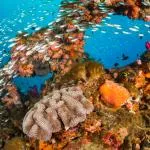
The oceans are a very important part of the planet and extend up to approximately 70% of the earth's surface. In addition to hosting a great biodiversity of organisms, having representatives of almost the majority of existing life forms, more than 90% of the exchanges of goods between countries are transported through their waters. Thus, the oceans and seas are a very important source of natural resources, although not inexhaustible, and many jobs and the economy of many countries depend on it.
If you are passionate about the sea and want to learn more about it, from Ecologist Verde we present this article where we focus on explaining to you what are the seabed, their types, photos and more.
What are the seabed
The littoral seabed form the sustenance of marine life and present a considerable extension, reaching from the upper part of the continental shelf with the littoral ecosystem and the coastal sands, up to the limit of the euphotic zone, a limiting margin where sunlight penetrates and photosynthetic activity can occur.
Typically, in the few meters of depth, are the communities of algae and plants, which are of great importance since they are an extraordinary source of oxygen and food.

Types of seabed
How many times have you bathed on the beach and looked at the bottom of the sea looking for any of its inhabitants? As you may have seen, the seabed can vary depending on the area in which you are swimming or diving, as well as if you swim further away or stay on the coast. There are different types of sea and ocean bottoms and, each one of the different typologies houses different marine ecosystems and a particular oceanic relief. Next, we detail the two different types of seabed that you can find:
Rocky seabed
They are hard bottoms, resistant to tides and sea currents and that correspond to the underground extension of the rocky land relief. Mollusks, algae, crustaceans, sponges, echinoderms, corals and cnidarians inhabit these bottoms.
Sandy seabed
They are soft bottoms, less common than the previous ones and typically present in marshes, canyons or estuaries, or in areas of great depth. This type of seabed is usually composed of small and fine materials, such as sand or silt among others. The most representative communities of this type of bottom are the seagrass meadows called Oceanic posedonia, characterized by a high ecological value. In turn, the fixation of these meadows creates habitat for many other species to establish refuges and breeding areas. However, these seagrass meadows are highly sensitive to the impacts of trawling, as well as pollution and the introduction of invasive species and / or pests.

Seafloor animals
The truth is that there are numerous marine organisms that live anchored in the seabed, of which the majority have entered the dispute to find a stable place to locate themselves. Now, there is hardly any surface of the seabed in which no life is found, and there is a seabed ecosystem impressive formed by a gradient of organisms that oscillates according to the temperature of the water, the luminosity that penetrates the waters, the depth of the seabed or the force of the waves, giving rise to a wide variety of ecosystems.
Thus, in the oceans, animals are distributed according to the environmental and social conditions that are most favorable for developing their life cycle. Some marine animal species that inhabit the seabed are:
- Wrasses
- Mud mullet
- Salps
- Blacksmiths
- Salvariego
- Sea spider
- Camerones
- Prawns
- Galleys
- Sea stars
- Cylindrical annelids
- Cockles
- Pocket knives
- Coquinas
- Clams
- Hunter crabs
- Lobsters
- Hedgehogs
- Mussels
- Oysters
- Sea acorns
- Sea slugs
- Spider crabs
- Sea oxen
- Groupers
- Brunettes
- Sea turtles
- Octopus
- Squid
- Cuttlefish
- Sponges
- Jellyfish
- Scorpores
- Torillos
If you want to discover more, we encourage you to see these 52 marine animals: characteristics, types and list.
The importance of the seabed
The seabed is of vital importance for marine life, as they provide sustenance for a multitude of species, the presence of which, in turn, provides habitat for other marine life. In fact, some deeper sea beds have been compared to tropical rainforests.
Years ago it was thought that this part of the oceans were simple plains without any life. However, the development of the first submersibles made it easier to submerge to great depths, which provided great discoveries about the seabed and its canyons, plains and seamounts. On the other hand, the seabed plays a key role, since they act as natural barriers against erosion or other phenomena that could alter it.
Thus, given the immense biodiversity that are home to these regions of the ocean, it is very important to ensure their conservation, as well as to avoid their destruction as much as possible. You may also be interested in reading about the different types of marine biomes in this other Green Ecologist article.
To finish, we show you some examples of seabed maps and one seabed image gallery.
 Image: Gisandbeers.com
Image: Gisandbeers.com Image: Gisandbeers.com
Image: Gisandbeers.com Image: ElComercio.es
Image: ElComercio.es Image: Muyinteresante.es
Image: Muyinteresante.es
If you want to read more articles similar to Seabed: what they are, types and photos, we recommend that you enter our Ecosystems category.
Photos of Seabed: what they are, types and photos





















